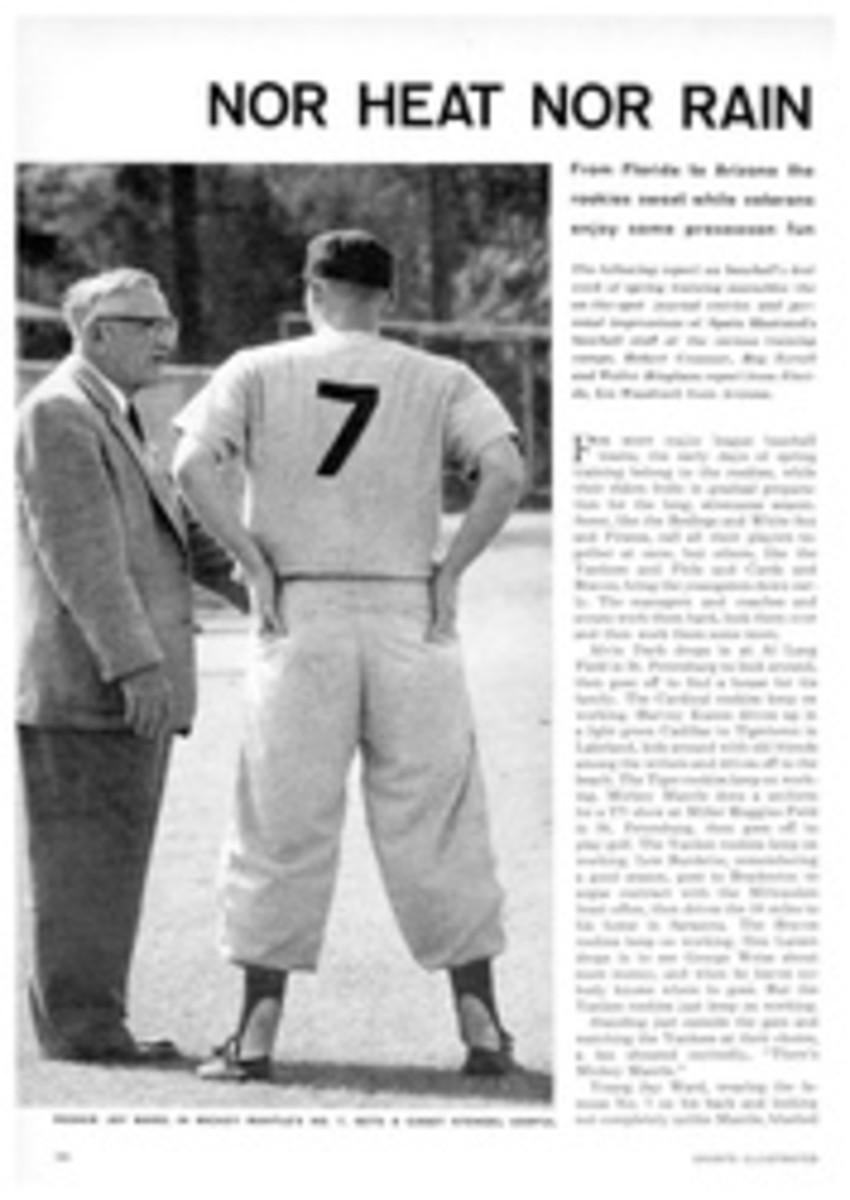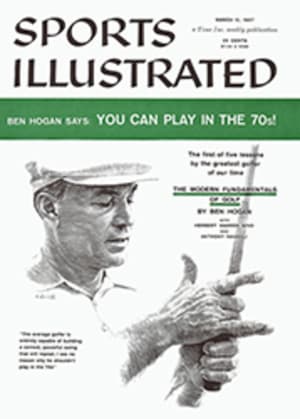
PATTERNS on HARDWOOD
The swirl of players on the opposite page, against a background of the Boston Garden's parquet floor, illustrates both the nature of professional basketball today and the chief reason for its rapidly accelerating popularity. The game is played by patterns rather than predetermined movements, and the variety of patterns is unlimited. Thus, as play follows play in speedy sequence, the knowing spectator has the fun of trying to anticipate what each participant will do to further or impede the progress of the ball upcourt to its ultimate destination—a metal ring 18 inches in diameter suspended 10 feet above the hardwood floor. And his guess, often, is as good as that of any man on the court.
For example, at the top of the page, New York's Carl Braun (4) has attempted to run Minneapolis Defender Vern Mikkelsen (19) into Braun's teammate, Richie Guerin (9). As a consequence, at least four different pattern plays may emerge:
1) If Braun's maneuver succeeds, Defender Bob Leonard (21) will switch from guarding Guerin to picking up Braun. At this instant, it appears that Braun is already half a step ahead of Mikkelsen so that the switch in assignments may take place even if Mikkelsen is not stopped completely.
2) If the switch takes place and Mikkelsen cannot recover in time to pursue Guerin closely, Braun may pass the ball to Richie for a close-in shot or layup.
3) If Mikkelsen does recover quickly but Leonard comes out slowly, Braun may stop suddenly and try his favorite overhead jump shot at the edge of the key.
4) Finally, Ray Felix (19) is obviously taking advantage of the fact that his defenseman, Clyde Lovellette (34), is watching the progress of Braun's maneuver. He is slipping away from Lovellette, and if he succeeds in getting clear under the basket, Braun may pass high to him for an easy tap-in.
There are, of course, a dozen possibilities. As soon as one is played out, a new pattern and its options will unfold. This is basketball at its best—demonstrated over a 4½ month season by 80 of the best players in the world.
Each team has its basic pattern on offense. The Boston Celtics use an essentially unchanging fast break (see page 22), depending on Bill Russell to get the rebound off the defensive board. He then passes out to Bob Cousy, who speeds upcourt with Bill Sharman trailing. If Cousy can go all the way, the result is a quick 2 points; if he can't, his first option is usually a pass back to Sharman for one of Bill's patented one-hand set shots.
Syracuse is one of the few clubs that still tries the old "eastern" style: a fast weave to shake a man loose. However, the 24-second clock, which forces a shot within that time, severely limits the number of passes that can be made toward that desired end. If the weave fails, there is Dolph Schayes driving, Ed Conlin cutting or Player-Coach Paul Seymour outside.
When Neil Johnston is on the floor, Philadelphia's strategy is to get the ball into him in the pivot for one of his hooks. If Johnston feels his chances are poor, his first option is to hit Paul Arizin in the corner, where Arizin is a marvel of accuracy. When Paul is being closely checked, which is often, he will instead come around in front of Johnston and take the pass at the top of the key for an almost unstoppable jump.
Of the near-infinite number of patterns, perhaps the oldest of all is still the most breathtaking when executed properly—the give-and-go. Sadly, it is seldom seen today, except when a pair of experts like Braun and Dick McGuire of the Knickerbockers are together on the court. It is played out exactly as its name implies. Two players come upcourt. The one with the ball passes or hands off to the other and cuts for the basket, receiving a return pass en route. On paper, it appears as simple as a turn in hopscotch, but, like most such tactical moves in or outside of basketball, its very simplicity demands that it be performed precisely in order to be successful. Both the give-and-goer and the passer must make exquisitely timed moves, feints and changes of direction. The spectator who watches Braun and McGuire closely as the Knicks put the ball in play insures for himself the opportunity of seeing possibly the most adroit and beautiful maneuvers in all sport.
PHOTO
HY PESKIN
PHOTO
HY PESKIN
At the end of a typical Boston fast break led by Bob Cousy, all five Celtics have arrived upcourt to only three Rochester defenders as Cousy takes jump shot
PHOTO
HY PESKIN
Rochester's Bob Burrow shoots a free throw, and now another classic pattern unfolds: the battle for the rebound

